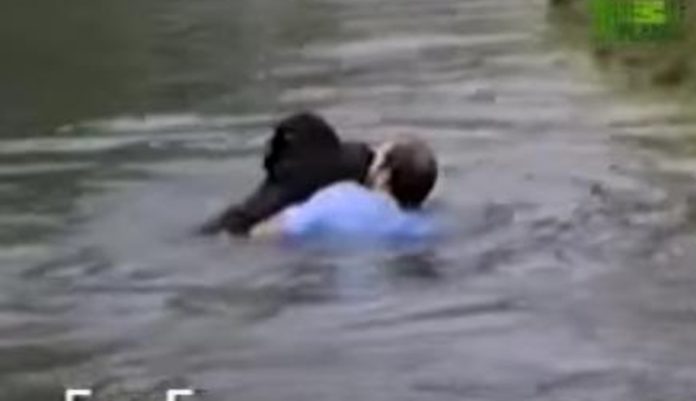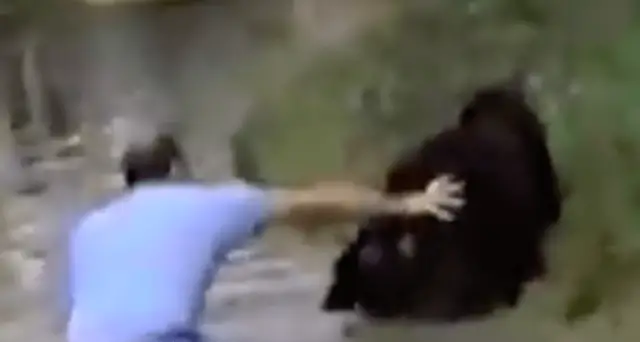Truck driver jumped into forbidden zoo enclosure to rescue a drowning Chimp when no one else would
Truck driver jumped into forbidden zoo enclosure to rescue a drowning Chimp when no one else would
Zoos tend to place signs around the enclosures of the animals, warning visitors not to get too close. However, that didn’t stop one brave truck driver from jumping inside one in order to save a chimpanzee’s life.
As Rick Swope, his wife, and their three children were admiring the animals at the Detroit zoo, they witnessed a fight breaking out between two male chimps.

Jo-Jo, one of the chimps which was less aggressive and tried to avoid the fight, fell into the the moat which was deep. The poor animal started drowning and people were just helplessly looking at him, still unaware of what was happening.
Then, Swope jumped into the water without hesitating even a bit. He grabbed the chimp and brought him back to safety. The onlookers were left in complete shock because of the incredible scene that unfolded in front of their eyes.
“It was the most pitiful thing I ever saw,” Swope said after the rescue. “This chimp had his hands up and his head was sticking out of the water. He was looking at the crowd. It was like he wanted someone to rescue him.”
During the rescue, the zoo staff kept telling Swope to get out, but he never thought of doing that without Jo-Jo. “People . . . were showing me which direction he was in,” Swope recalled. “The water was so dirty you couldn`t see through it. I swam around on the bottom. Finally I found him.”

Luckily, Swope managed to get Jo-Jo over a cable designed to keep chimps from slipping in the moat.
“He was pretty lifeless, but you could see he was still alive. He was looking at me. I think he knew what was going on,” Swope said.
Jo-Jo looked straight into Swope’s eyes as though he was saying thank you. He was aware a man saved his life that day.
“Well, you see, I happened to look into his eyes, and it was like looking into the eyes of a man, and the message was, ‘Won’t anybody help me?’”

Jane Goodall from the zoo said how Jo-Jo’s life wasn’t an easy one. He was brought to the zoo when he was very young after his mom was killed by poachers.
“[But] if you see that look with your eyes, and you feel it in your heart, you have to jump in and try to help,” she said.
This is definitely one of the most dramatic rescues you’ve ever seen. Swope is such an incredible man. He risked his life for an animal’s and that speaks a lot of his bravery.
Please SHARE this touching story with your family and friends on Facebook!
2028 United States presidential election

2028 United States presidential election

Presidential elections are scheduled to be held in the United States on November 7, 2028, to elect the president and vice president for a term of four years.
In the 2024 elections, the Republican Party retained its majority in the House of Representatives and gained control of the Senate. Then-former president Donald Trump won a non-consecutive second term; he is ineligible for a third term as per the term limits imposed by the 22nd amendment to the US Constitution.
Background
The Republican Party returned to power in the United States in January 2025 with a government trifecta following the 2024 elections. Donald Trump, who was elected president in 2016 but lost a re-election bid in 2020 to Joe Biden, defeated Vice President Kamala Harris, who began her campaign following Biden's exit from the 2024 election. This election also saw JD Vance, a then-senator from Ohio, defeat Minnesota governor Tim Walz for the vice presidency. Trump's victory was credited to a post-pandemic surge in inflation,[a] a migrant crisis at the U.S.–Mexico border,[b] and a global anti-incumbent backlash.[7][8][9] In addition, Republicans secured control of the Senate, flipping four seats and earning a three-seat majority, while also retaining a House majority, though the party's majority narrowed to three seats after losing two seats.[10]
Electoral system
The president and vice president of the United States are elected through the Electoral College, determined by the number of senators and representatives with an additional three representatives for Washington, D.C. A majority of 270 votes is needed to win the election. Forty-eight states use a winner-take-all system, in which states award all of their electors to the winner of the popular vote. In Maine and Nebraska, two votes are allocated to the winner of the popular vote, while each of the individual congressional districts have one vote. Electoral votes are certified by state electors in December and by Congress on January 6.
Election Day in the United States is held on the first Tuesday that falls after the first Monday in November.
Eligibility
The United States Constitution limits occupancy of the presidency to individuals who are at least thirty-five, who have been a resident in the United States for at least fourteen years, and who are a natural-born citizen.[16] For instance, Elon Musk, most well known for his leadership of Tesla, SpaceX, and X (formerly Twitter), is ineligible to serve as president as he is a naturalized citizen who was born in South Africa.[17] Section three of the Fourteenth Amendment prevents current and former federal, state, and military officials from holding office—including the presidency—if they have "engaged in insurrection or rebellion" against the United States;[18] in March 2024, the Supreme Court unanimously ruled in Trump v. Anderson that former president Donald Trump could seek office after challenges to his ballot eligibility were raised by several state attorneys general.[19] A convicted felon may serve as president.[20]
Incumbent president Trump along with former presidents Bill Clinton, George W. Bush, and Barack Obama are ineligible to be elected to a third term, as the Twenty-second Amendment forbids any person from being elected president more than twice.[21] Nonetheless, Trump has repeatedly suggested running for a third term, an idea supported by several of his allies, including Steve Bannon.[22] In January 2025, Tennessee representative Andy Ogles proposed a resolution to amend the Twenty-second Amendment, allowing for presidents who have served two non-consecutive terms to seek a third term. The amendment would not permit living presidents Bill Clinton, George W. Bush, or Barack Obama to run for a third term, due to the allowed third term being contingent on the first two being served non-consecutively.[23] At CPAC 2025, conservative groups, such as the Third Term Project, supported Ogles' resolution and promoted the idea of Trump running for an as-yet unconstitutional third term.[24][25] In response, New York Democratic representative Dan Goldman planned to introduce a resolution affirming the Twenty-second Amendment.[26]
In March, Trump floated the possibility of serving a third term in an interview with NBC News, saying "A lot of people want me to do it. But, I mean, I basically tell them we have a long way to go, you know, it's very early in the administration. I'm focused on the current." He added that "there are methods" to run for a third term and that he was "not joking".[27] On April 24, 2025, multiple news outlets reported that the Trump store was selling "Trump 2028" hats.[28][29] In a May interview with NBC News, Trump said he would make it his goal to only serve two terms and named JD Vance and Marco Rubio as potential successors.[30] Trump said in an August interview on CNBC's Squawk Box that he would "probably not" run for a third term, though he would like to.[31] Later that month, Trump quipped that he could cancel the 2028 elections if the United States was at war.[32] During a meeting before the 2025 government shutdown with Hakeem Jeffries and Chuck Schumer, Trump had red hats with Trump 2028 emblazoned on the front. Jeffries later spoke after Trump posted a AI generated video to Truth Social of him throwing the hats at Jeffries, indicating the hats had appeared on the desk during the meeting and when he asked JD Vance if Vance had a problem with it, Vance responded "No comment".[33] Bannon stated in an October 2025 interview that there were "alternatives" to ensuring Trump would be on the ballot in 2028.[34]
Most U.S. states are usually not highly competitive in presidential elections, often voting consistently for the same party due to longstanding demographic and ideological differences. In the Electoral College, this results in major-party candidates primarily focusing their campaigns on swing states, which can swing between parties from election to election. These states are critical for a presidential candidate's path to victory. For 2028, the expected swing states likely include the Rust Belt states of Pennsylvania, Wisconsin, and Michigan, and the Sun Belt states of Arizona, Georgia, Nevada, and North Carolina, all of which narrowly voted for Trump in 2024.[35][36][37] Other possible swing states include traditional Democratic strongholds that shifted toward Trump and were only narrowly won by Harris in 2024: New Jersey[38][39] and Minnesota;[40] though 2025 polls show a reversal of pro-Trump trends.[41]
States formerly considered swing states, such as Florida, Iowa, and Ohio, voted for Trump in all three of his previous election bids, as well as for Republican candidates in other state and federal elections, with increasing margins in each election and are now seen as solidly red states.[42][43][44] Former red or swing states that, since 2008, have consistently voted Democratic include Colorado, New Hampshire, New Mexico, and Virginia.[45] Due to its recent record of voting Democratic even during Republican national victories, Nebraska's 2nd congressional district has been called "the Blue Dot"





